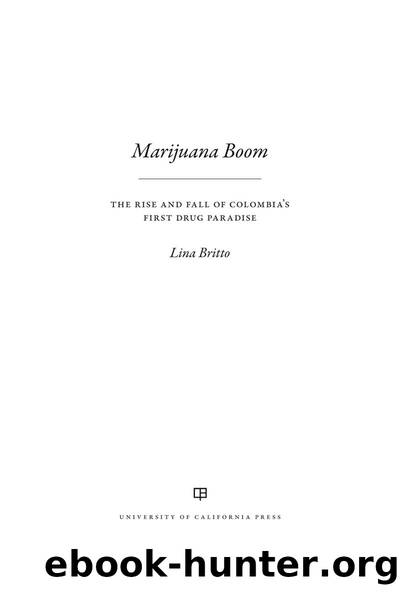Marijuana Boom by Lina Britto

Author:Lina Britto [Britto, Lina]
Language: eng
Format: epub
Tags: History, Latin America, General
ISBN: 9780520325470
Google: A33HDwAAQBAJ
Publisher: Univ of California Press
Published: 2020-03-24T01:11:34+00:00
FIGURE 16. Ernesto Samper Pizano, director of the National Association of Financial Institutions, delivers a keynote speech at ANIFâs conference on legalization of marijuana, March 16, 1979. El Espectador photographic archive, Bogotá.
Like Matallana, a group of young technocrats made legalization of marijuana a topic of political debate. On March 15 and 16, 1979, the National Association of Financial Institutions (ANIF), Colombiaâs most respected think tank, held a conference in Bogotá attended by Colombian and US government officials, diplomats, scientists, and the press.138 During his keynote speech, US ambassador Diego Asencio stated firmly that legalizing marijuana unilaterally would turn the country into âa pirate nation.â He then praised President Turbay for âhis bold stance,â and assured the audience that âthe Two Peninsulas campaign has been a success and will continue to be one; there is no need to get bitter because of the traffickersâ excesses; it is possible to eradicate this problem from Colombia.â139 Finally, using the fieldwork conducted by engineer Rodrigo Echeverriâs Inderena team, along with DEA satellite information, ANIF bombarded the public with statistics.140 According to Hernando Ruiz, ANIFâs lead researcher, the annual value of marijuana exports were equal to 83 percent of Colombiaâs coffee exports and constituted 39 percent of the countryâs total exports. The Caribbean coast produced 60 percent of the total, and traffickers exported 85 percent of Colombiaâs marijuana through the natural ports and desert plains of the Guajira.141 Also at the ANIF conference was its chair, Ernesto Samper Pizano. A twenty-nine-year-old lawyer and economist from a reputed family, he would later become president (1994â98) amidst the greatest scandal in the countryâs history due to the cocaine cartelsâ financial patronage of a political campaign. At the 1979 conference, Samper Pizano delivered one of its most controversial addresses, arguing that the social and political costs of repressing marijuana âat the sourceâ was producing costly economic side-effects that could be converted into gains if the state regulated production and commercialization. Samper Pizano asked governments to create a bilateral commission to study production in Colombia and consumption in the United States in order to provide recommendations on how to proceed with legalization in both countries simultaneously.142
The ANIF chairâs proposal was unorthodox in many ways, but one feature stands out in particular. The exclusive focus on marijuana overlooked cocaine entirely, despite the fact that the latter was the drug coming from Colombia that most concerned the Carter administration. Hernando Ruiz explained to me in his office in Bogotá that ANIF disregarded cocaine because they considered marijuana to be âthe vehicle for the gestation of macrosocial, macroeconomic, and macropolitical dynamics.â In other words, âmarijuana was very suitable to our [Colombiaâs] productive idiosyncrasy because we are not used to producing value added.â143 Building upon tradition, marijuana cultivators and merchants established linkages between Colombia and the United States that produced unprecedented profits. To ANIFâs economists, this represented as dramatic a turning point in Colombiaâs history as the shift that had taken place in the late nineteenth and early twentieth centuries with coffee.144 The
Download
This site does not store any files on its server. We only index and link to content provided by other sites. Please contact the content providers to delete copyright contents if any and email us, we'll remove relevant links or contents immediately.
| Argentina | Bolivia |
| Brazil | Chile |
| Colombia | Ecuador |
| Guyana | Paraguay |
| Peru | Suriname |
| Uruguay | Venezuela |
Cat's cradle by Kurt Vonnegut(15155)
Pimp by Iceberg Slim(14322)
4 3 2 1: A Novel by Paul Auster(12263)
Underground: A Human History of the Worlds Beneath Our Feet by Will Hunt(11997)
The Radium Girls by Kate Moore(11900)
Wiseguy by Nicholas Pileggi(5649)
Perfect Rhythm by Jae(5306)
American History Stories, Volume III (Yesterday's Classics) by Pratt Mara L(5240)
The Fire Next Time by James Baldwin(5224)
Paper Towns by Green John(5065)
Pale Blue Dot by Carl Sagan(4886)
A Higher Loyalty: Truth, Lies, and Leadership by James Comey(4822)
The Mayflower and the Pilgrims' New World by Nathaniel Philbrick(4403)
The Doomsday Machine by Daniel Ellsberg(4397)
Killers of the Flower Moon: The Osage Murders and the Birth of the FBI by David Grann(4368)
The Sympathizer by Viet Thanh Nguyen(4287)
Too Much and Not the Mood by Durga Chew-Bose(4256)
The Borden Murders by Sarah Miller(4216)
Sticky Fingers by Joe Hagan(4086)
